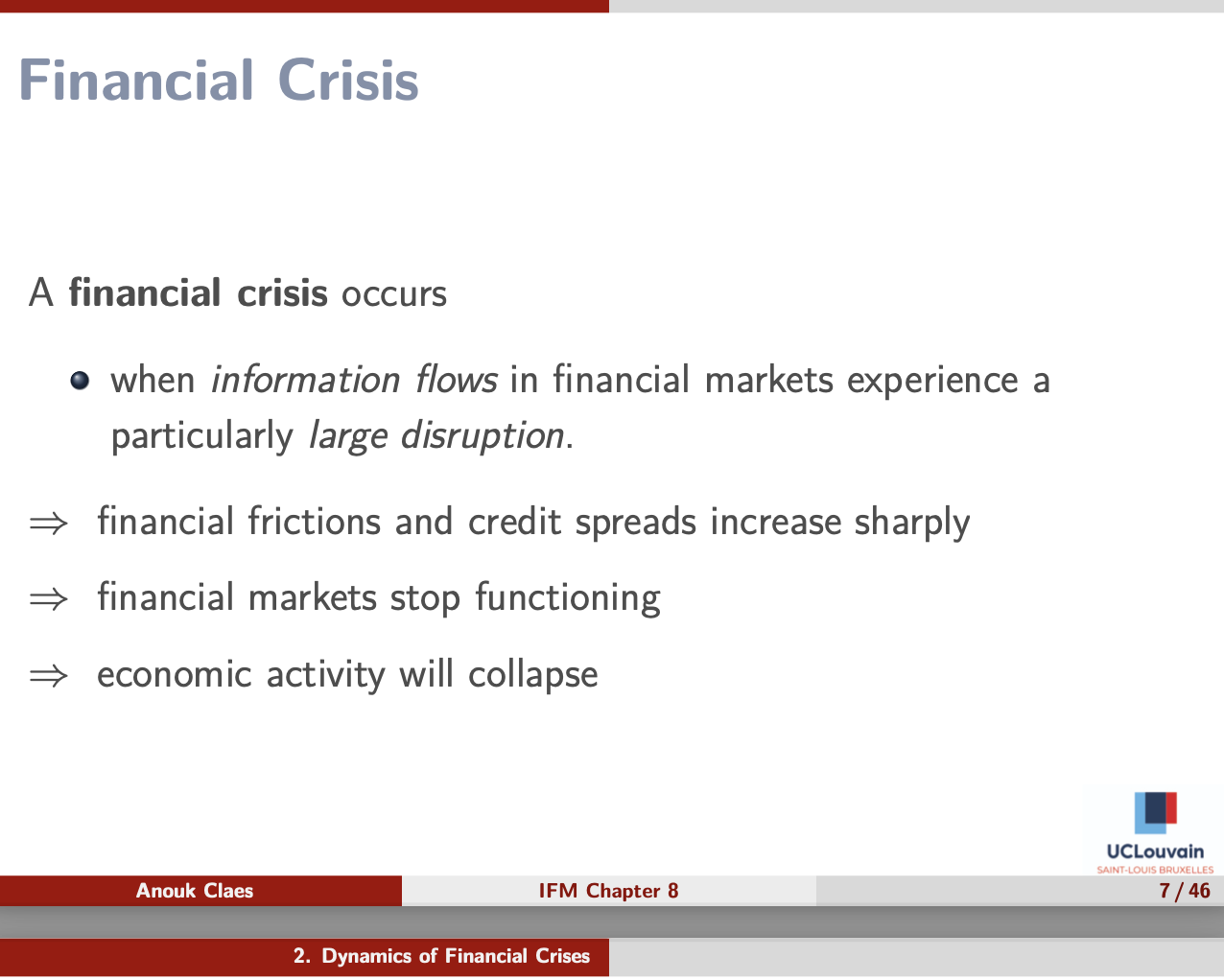IFM - chapter 8 - why do financial crises occur and why are they so damaging to the economy?
1/12
There's no tags or description
Looks like no tags are added yet.
Name | Mastery | Learn | Test | Matching | Spaced |
|---|
No study sessions yet.
13 Terms
what is a financial crisis?
= major disruptions in financial markets characterized by
sharp declines in asset prices and firm failures.
What is meant by financial frictions?
real-world imperfections that prevent perfect, frictionless flow of capital in the economy.
ex. Asymmetric information problems act as a barrier to financial markets channeling funds efficiently from savers to households and firms with productive investment opportunities
when do financial crisis occur?

what ways can financial crisis begin? 3
Credit Boom and Bust
Asset-Price Boom and bust
Increase in Uncertainty
explain credit boom and bust
Financial innovation = introduction of new loans or financial
products
followed by financial liberalization = elimination of restrictions on financial markets and institutions
Government safety nets, such as deposit insurance,
- weaken market discipline: Depositors ignore bank risk-taking.- increase the moral hazard incentive for banks to take on greater risk than they otherwise would.
⇒ loan losses accrue, and asset values fall, leading to a reduction in capital.
⇒ Deleveraging = Financial institutions cut back in lending, and banking funding falls.Deleveraging
⇒ The financial system losses its primary institution to address adverse selection and moral hazard.
⇒ Economic spending contracts as loans become scarce.
explain asset boom and bust
A pricing bubble starts = asset values exceed their
fundamental values.
When the bubble bursts
⇒ prices fall,
⇒ corporate net worth falls.
⇒ Moral hazard increases (firms have little to lose) ⇒ FIs see a fall in assets
⇒ Deleveraging.
explain increased uncertainty in the initial stage of economic crisis
stock market crashes or the failure of a major financial institution.
Examples:
2008: AIG, Bear Sterns, and Lehman Bros. failed Information was hard to come by,
⇒ moral hazard and adverse selection problems increased, ⇒ lending and economic activit decreased
explain banking crisis in stage 2 of financial crisis
Deteriorating balance sheets lead financial institutions into insolvency.
If severe enough, these factors can lead to a bank panic.
= when depositors are unsure which banks are insolvent, causing all depositors to withdraw all funds immediately
As cash balances fall
⇒ FIs must sell assets quickly
⇒ further deteriorating their balance sheet
what is debt deflation in stage 3 of financial crisis?
=when a substantial unanticipated decline in the price level sets in, leading to a further deterioration in firms’ net worth because of the increased burden of indebtedness.
When prices fall, the real value of debt increases. This means that borrowers have to pay back more in real terms than they initially borrowed.
⇒ If the crisis also leads to a sharp decline in prices, debt deflation can occur, where asset prices fall, but debt levels do not adjust, increasing debt burdens.
⇒ an increase in adverse selection and moral hazard, which is followed by decreased lending
⇒ Economic activity remains depressed for a long time
what were the three central factors of the global financial crisis of 2007-2008?
Financial innovation in mortgage markets
Agency problems in mortgage markets
The role of asymmetric information in the credit rating process
what are the names of rated tranches?

what is the shadow banking system?
the hedge funds, investment banks, and other liquidity providers in our financial system.
What is meant by bubble?
Unsustainable increase in the price of a class of assets (tulip bubble, housing bubble…)